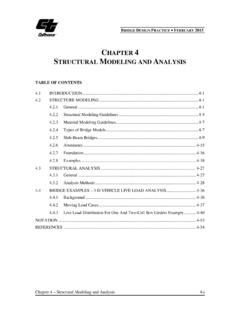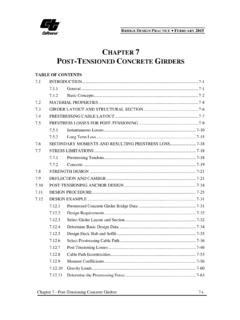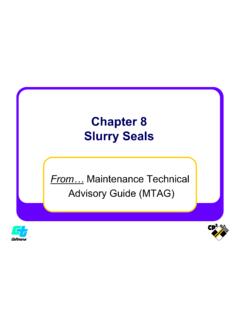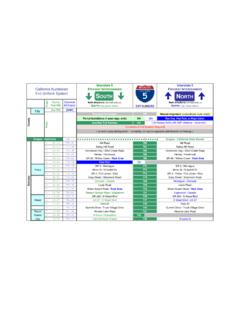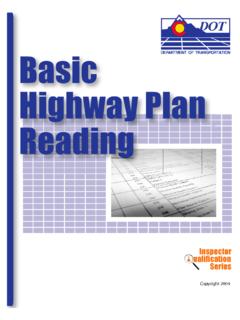Transcription of CHAPTERS 600 670 PAVEMENT ENGINEERING CHAPTER …
1 highway Design Manual 600-1. July 1, 2020. CHAPTERS 600 670 PAVEMENT . ENGINEERING . CHAPTER 600 GENERAL ASPECTS. Topic 601 Introduction PAVEMENT ENGINEERING involves the determination of the type and thickness of PAVEMENT surface course, base, and subbase layers that in combination are cost effective and structurally adequate for the projected traffic loading, service life, and specific project conditions including climate. This combination of roadbed materials placed in layers above the subgrade (also known as basement soil) is referred to as the " PAVEMENT " or the " PAVEMENT structure". The Department guidelines and standards for pavements described in this manual are based on extensive ENGINEERING research and field experience, including the following: Theoretical concepts in PAVEMENT ENGINEERING and analysis.
2 Data obtained from test track studies and experimental sections. Research on materials characteristics, testing methods, and equipment. Observation of performance throughout the State and the Nation. The PAVEMENT should be engineered using the standards and guidance described in this manual to ensure consistency throughout the State and provide a PAVEMENT structure that will have adequate strength, ride quality, and durability to carry the projected traffic loads for the design life of each project. The final PAVEMENT structure for each project should be based on a thorough investigation of specific project conditions including subgrade soils and structural materials, environmental conditions, projected traffic, cost effectiveness, and the performance of other pavements in the same area or similar climatic and traffic conditions.
3 These factors are discussed in CHAPTER 610 of this manual. The standards, procedures and requirements found in this manual are best practices and should not preclude ENGINEERING judgment based on experience, and knowledge of the local conditions when developing PAVEMENT structures for individual projects. Topic 602 PAVEMENT Structure Layers Index Description PAVEMENT structures are comprised of one or more layers of select materials placed above the subgrade. The basic PAVEMENT layers of the roadway are discussed below. (1) Subgrade. It is the portion of the roadbed consisting of native or treated soil on which surface course, base, subbase, or a layer of any other material is placed.
4 Subgrade may 600-2 highway Design Manual July 1, 2020. be composed of either in-place material that is exposed from excavation, or embankment borrow material that is placed to elevate the roadway above the surrounding natural ground. Subgrade soil characteristics are discussed in Topic 614. (2) Subbase. It is the unbound or treated aggregate or granular material that is placed on the subgrade as a foundation or working platform for the base. It functions primarily as structural support but it can also minimize the intrusion of fines from the subgrade into the PAVEMENT structure, improve drainage , and minimize frost action damage. The subbase generally consists of lower quality materials than the base but better than the subgrade soils.
5 Subbase may not be needed in areas with high quality subgrade or where it is more cost effective to build a thicker base layer. Further discussion on subbase materials and concepts can be found in CHAPTER 660. (3) Base. It is the select, processed, and/or treated aggregate material that is placed immediately below the surface course. It provides additional load distribution and contributes to drainage and frost resistance. Base may be one or multiple layers treated with cement, asphalt or other binder material, or may consist of untreated aggregate. In some cases, the base may include a drainage layer to drain water that seeps into the base. The aggregate in base is typically a higher quality material than that used in subbase.
6 Further discussion on base materials and concepts can be found in CHAPTER 660. (4) Surface Course. It represents one or more layers of the PAVEMENT structure engineered to accommodate and distribute traffic loads, provide skid resistance, minimize disintegrating effects of climate, reduce tire/ PAVEMENT noise, improve surface drainage , and minimize infiltration of surface water into the underlying base, subbase and subgrade. Sometimes referred to as the surface layer, the surface course may be composed of a single layer, constructed in one or more lifts of the same material, or multiple layers of different materials. Pavements are generally classified based on the type of surface course, as follows: (a) Flexible Pavements.
7 These are pavements in which the surface course is an asphalt bound structural layer underlain with a non-rigid base. This type of pavements is engineered to bend or flex when loaded. Flexible pavements transmit and distribute traffic loads to the underlying layers. The highest quality layer is the surface course, which typically consists of one or more layers of asphalt concrete and may or may not incorporate underlying layers of base and/or subbase. These types of pavements are called "flexible" because the total PAVEMENT structure bends (or flexes) to accommodate deflection bending under traffic loads. Procedures for flexible pavements can be found in CHAPTER 630. (b) Rigid Pavements.
8 These are pavements with a rigid surface course typically a slab of Portland cement concrete (or a variety of specialty hydraulic cement concrete mixes used for rapid strength concrete) over underlying layers of stabilized or unstabilized base or subbase materials. These types of pavements rely on the substantially higher stiffness of the concrete slab to distribute the traffic loads over a relatively wide area of underlying layers and the subgrade. Some rigid concrete slabs have reinforcing steel to help resist cracking due to temperature changes and repeated loading. Procedures for rigid pavements can be found in CHAPTER 620. highway Design Manual 600-3. July 1, 2020. (c) Composite Pavements.
9 These are pavements comprised of both flexible (asphalt concrete) and rigid (cement concrete) layers over underlying layers of stabilized or unstabilized base or subbase materials. In California, composite pavements consist mostly of existing rigid pavements that have been overlaid with hot mix asphalt (HMA), open graded friction course (OGFC), or rubberized hot mix asphalt (RHMA). Refer to CHAPTER 640 for additional information on composite pavements. (5) Non-Structural Wearing Course. On some pavements, a non-structural wearing course is placed to protect the surface course from wear and tear from tire/ PAVEMENT interaction, the weather, and other environmental factors.
10 Examples of non-structural wearing courses include OGFC, various types of surface seals, and added surface course thickness to allow for chain wear or grinding. Non-structural wearing courses are also placed over pavements to reduce noise and improve wet weather condition. Although non-structural wearing courses are not given a structural value in the procedures and tables found in this manual, they will improve the service life of the PAVEMENT by protecting it from traffic and environmental effects. (6) Others. Depending on the type of PAVEMENT built and the subgrade or existing soil conditions encountered, additional layers may be included in the PAVEMENT . Some of these layers include: (a) Interlayers can be used between PAVEMENT layers or within PAVEMENT layers to reinforce PAVEMENT and/or improve resistance of HMA layers to reflective cracking.
